Tesco Operations Management: Leadership, Efficiency, and Roles
VerifiedAdded on 2020/10/22
|17
|5003
|166
Report
AI Summary
This report delves into the realm of operations management, focusing on the roles of leaders and managers within an organization, specifically using Tesco as a case study. It explores the distinct characteristics of leaders and managers, examining how their functions are influenced by various organizational situations such as conflict, change adoption, and new product development. The report then applies different leadership theories, including situational, systems, and contingency leadership, to illustrate their practical application. Furthermore, it analyzes the roles of operation managers in enhancing efficiency and decision-making processes. The report also covers key elements and approaches of diverse operations management systems and identifies factors that impact business operations. Overall, the report offers a comprehensive overview of operations management principles and their impact on business performance.

OPERATIONS
MANAGEMENT
MANAGEMENT
Paraphrase This Document
Need a fresh take? Get an instant paraphrase of this document with our AI Paraphraser

Table of Contents
INTRODUCTION...........................................................................................................................2
TASK 1............................................................................................................................................2
a. Explaining the roles and characteristics of leaders and managers. ........................................2
b. Explaining the different situation in within the organization can affect the role of a leader
functions of a manager................................................................................................................4
c. Applying the range of theories to leadership situational, systems leadership and contingency
leadership theories ......................................................................................................................5
TASK 2............................................................................................................................................7
a. Roles of operation managers with regards to improving efficiency and decision and they
make............................................................................................................................................7
b. Key elements and approaches of different operations' management system..........................8
c. Various factors impacting business operations.....................................................................13
CONCLUSION..............................................................................................................................15
REFERENCES .............................................................................................................................16
1
INTRODUCTION...........................................................................................................................2
TASK 1............................................................................................................................................2
a. Explaining the roles and characteristics of leaders and managers. ........................................2
b. Explaining the different situation in within the organization can affect the role of a leader
functions of a manager................................................................................................................4
c. Applying the range of theories to leadership situational, systems leadership and contingency
leadership theories ......................................................................................................................5
TASK 2............................................................................................................................................7
a. Roles of operation managers with regards to improving efficiency and decision and they
make............................................................................................................................................7
b. Key elements and approaches of different operations' management system..........................8
c. Various factors impacting business operations.....................................................................13
CONCLUSION..............................................................................................................................15
REFERENCES .............................................................................................................................16
1
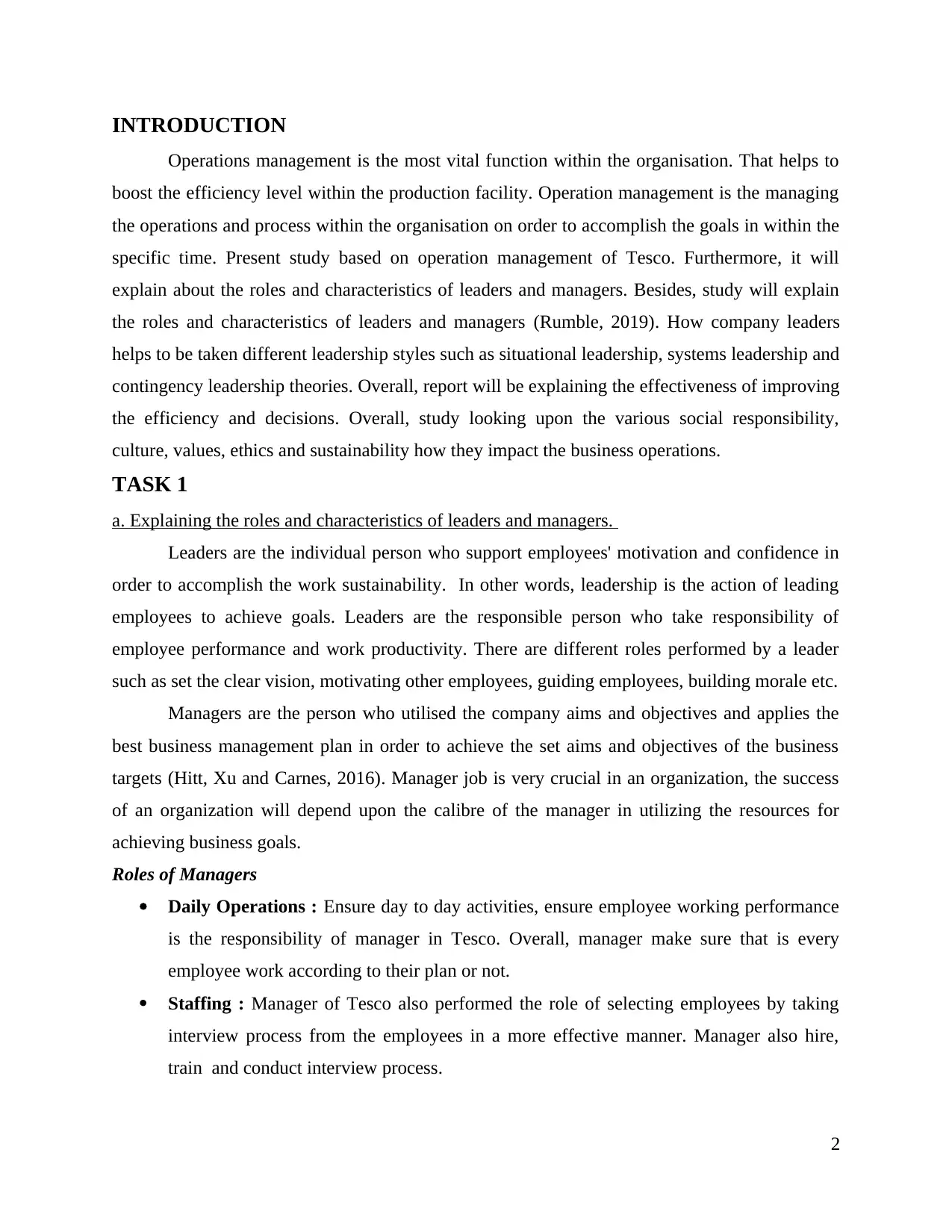
INTRODUCTION
Operations management is the most vital function within the organisation. That helps to
boost the efficiency level within the production facility. Operation management is the managing
the operations and process within the organisation on order to accomplish the goals in within the
specific time. Present study based on operation management of Tesco. Furthermore, it will
explain about the roles and characteristics of leaders and managers. Besides, study will explain
the roles and characteristics of leaders and managers (Rumble, 2019). How company leaders
helps to be taken different leadership styles such as situational leadership, systems leadership and
contingency leadership theories. Overall, report will be explaining the effectiveness of improving
the efficiency and decisions. Overall, study looking upon the various social responsibility,
culture, values, ethics and sustainability how they impact the business operations.
TASK 1
a. Explaining the roles and characteristics of leaders and managers.
Leaders are the individual person who support employees' motivation and confidence in
order to accomplish the work sustainability. In other words, leadership is the action of leading
employees to achieve goals. Leaders are the responsible person who take responsibility of
employee performance and work productivity. There are different roles performed by a leader
such as set the clear vision, motivating other employees, guiding employees, building morale etc.
Managers are the person who utilised the company aims and objectives and applies the
best business management plan in order to achieve the set aims and objectives of the business
targets (Hitt, Xu and Carnes, 2016). Manager job is very crucial in an organization, the success
of an organization will depend upon the calibre of the manager in utilizing the resources for
achieving business goals.
Roles of Managers
Daily Operations : Ensure day to day activities, ensure employee working performance
is the responsibility of manager in Tesco. Overall, manager make sure that is every
employee work according to their plan or not.
Staffing : Manager of Tesco also performed the role of selecting employees by taking
interview process from the employees in a more effective manner. Manager also hire,
train and conduct interview process.
2
Operations management is the most vital function within the organisation. That helps to
boost the efficiency level within the production facility. Operation management is the managing
the operations and process within the organisation on order to accomplish the goals in within the
specific time. Present study based on operation management of Tesco. Furthermore, it will
explain about the roles and characteristics of leaders and managers. Besides, study will explain
the roles and characteristics of leaders and managers (Rumble, 2019). How company leaders
helps to be taken different leadership styles such as situational leadership, systems leadership and
contingency leadership theories. Overall, report will be explaining the effectiveness of improving
the efficiency and decisions. Overall, study looking upon the various social responsibility,
culture, values, ethics and sustainability how they impact the business operations.
TASK 1
a. Explaining the roles and characteristics of leaders and managers.
Leaders are the individual person who support employees' motivation and confidence in
order to accomplish the work sustainability. In other words, leadership is the action of leading
employees to achieve goals. Leaders are the responsible person who take responsibility of
employee performance and work productivity. There are different roles performed by a leader
such as set the clear vision, motivating other employees, guiding employees, building morale etc.
Managers are the person who utilised the company aims and objectives and applies the
best business management plan in order to achieve the set aims and objectives of the business
targets (Hitt, Xu and Carnes, 2016). Manager job is very crucial in an organization, the success
of an organization will depend upon the calibre of the manager in utilizing the resources for
achieving business goals.
Roles of Managers
Daily Operations : Ensure day to day activities, ensure employee working performance
is the responsibility of manager in Tesco. Overall, manager make sure that is every
employee work according to their plan or not.
Staffing : Manager of Tesco also performed the role of selecting employees by taking
interview process from the employees in a more effective manner. Manager also hire,
train and conduct interview process.
2
⊘ This is a preview!⊘
Do you want full access?
Subscribe today to unlock all pages.

Trusted by 1+ million students worldwide

Setting goals : Managers who prepare plan and roles and responsibilities of people.
Manager is the individual who articulate both short and long term goals to ensure a
company longevity.
Liaising : Although a manager typically oversees a group of employees, managers also
effectively communicate with their bosses and convey the necessary information to the
various company parties. Administration : Managers also handle the functioning of administration where they
conductor ensure the proper activity handled by the employees or not.
Roles of Leaders
Representative of the organization : Leader is the person or a role model of the
employees who always motivate them and make them satisfied within the company
environment. Leaders communicate employees queries, issues and conflicts to the top
managements.
Motivating employees : Motivating employees is the initial or foremost role of a leader.
Such as providing appreciation, enhance employee motivation, manager the working
atmosphere etc. through company can better achieve the targets and opportunities. Building employee morale : Leaders pull everyone towards the company aims and
objectives and let them work together (Reid and Sanders, 2015). Leaders of Tesco
appreciate their employees work into the correct direction that motivates towards the new
working targets and long lasting relationship.
Characteristics of leader
Leaders are motivated and enthusiastic towards performing the work goals.
Leaders are honest and loyal towards the employees issues and company goals.
Leaders are also known for its excellent scene of humour and positive attitudes. Leaders have power to enhance the creative attitude and challenging business behaviour.
Characteristics of manager
Manager gives good direction to employees to get the target more frequently.
Good managers must be able to present their ideas and thoughts to the other people.
Managers are the problem solver who solves the employee issues and conflicts among the
other employees.
3
Manager is the individual who articulate both short and long term goals to ensure a
company longevity.
Liaising : Although a manager typically oversees a group of employees, managers also
effectively communicate with their bosses and convey the necessary information to the
various company parties. Administration : Managers also handle the functioning of administration where they
conductor ensure the proper activity handled by the employees or not.
Roles of Leaders
Representative of the organization : Leader is the person or a role model of the
employees who always motivate them and make them satisfied within the company
environment. Leaders communicate employees queries, issues and conflicts to the top
managements.
Motivating employees : Motivating employees is the initial or foremost role of a leader.
Such as providing appreciation, enhance employee motivation, manager the working
atmosphere etc. through company can better achieve the targets and opportunities. Building employee morale : Leaders pull everyone towards the company aims and
objectives and let them work together (Reid and Sanders, 2015). Leaders of Tesco
appreciate their employees work into the correct direction that motivates towards the new
working targets and long lasting relationship.
Characteristics of leader
Leaders are motivated and enthusiastic towards performing the work goals.
Leaders are honest and loyal towards the employees issues and company goals.
Leaders are also known for its excellent scene of humour and positive attitudes. Leaders have power to enhance the creative attitude and challenging business behaviour.
Characteristics of manager
Manager gives good direction to employees to get the target more frequently.
Good managers must be able to present their ideas and thoughts to the other people.
Managers are the problem solver who solves the employee issues and conflicts among the
other employees.
3
Paraphrase This Document
Need a fresh take? Get an instant paraphrase of this document with our AI Paraphraser

Managers prepare the good business plan in order to accomplish the task within time
period.
Managers is the goal oriented who only focuses on the company aims and objectives.
Managers in Tesco are very well in delegation of duties and responsibilities to
employees.
b. Explaining the different situation in within the organization can affect the role of a leader
functions of a manager.
Situation 1: Conflict among employees
Conflict management is the term that can help managers or leaders to manage the overall
company situation and try to resolve the employees conflict in proper way. Besides, in this
process manager role play is to encourage participants to share and discuss the issues and reason
of conflict (Khanna, 2015). In other words, conflict among employees would have been given
negative impact on the employee performance that directly affect the company outputs. So in this
situation manager and leaders should have required to take some action plan to get out of this
problem. On the other hand, leaders also plays a most important role to motivate them into the
best practices or by the help of leadership styles. That affect the good outcomes and results for
better problem solving approach.
However, leader and manager role definitely effect having the disputes among
employees. So in order to handle the conflict situation by handling employee behaviour,
collaborating, compromising, avoiding and accommodating.
Situation 2: Adopt new Change
Adopting the new change or some modifying in the business structure within the
organization is the another most often situation that company adopts in order to get customer
attention and sustain market growth. So in this particular situation, leaders and mangers has
faced different mood swings of an employee to not accepting the new change. So in that
situation, leaders should need to performed to get the situation normal and sustained. Besides,
managers manage and delegate the responsibilities as per the employees roles and duty. By this
situation leader get highly affected where they have to work or stable the situation with different
approaches as well (Mahadevan, 2015). This situation affects the role of leaders and mangers by
creating challenges and threats to perform the business function. This situation arise
competencies dealing with people which is sometimes is not possible for managers and leaders.
4
period.
Managers is the goal oriented who only focuses on the company aims and objectives.
Managers in Tesco are very well in delegation of duties and responsibilities to
employees.
b. Explaining the different situation in within the organization can affect the role of a leader
functions of a manager.
Situation 1: Conflict among employees
Conflict management is the term that can help managers or leaders to manage the overall
company situation and try to resolve the employees conflict in proper way. Besides, in this
process manager role play is to encourage participants to share and discuss the issues and reason
of conflict (Khanna, 2015). In other words, conflict among employees would have been given
negative impact on the employee performance that directly affect the company outputs. So in this
situation manager and leaders should have required to take some action plan to get out of this
problem. On the other hand, leaders also plays a most important role to motivate them into the
best practices or by the help of leadership styles. That affect the good outcomes and results for
better problem solving approach.
However, leader and manager role definitely effect having the disputes among
employees. So in order to handle the conflict situation by handling employee behaviour,
collaborating, compromising, avoiding and accommodating.
Situation 2: Adopt new Change
Adopting the new change or some modifying in the business structure within the
organization is the another most often situation that company adopts in order to get customer
attention and sustain market growth. So in this particular situation, leaders and mangers has
faced different mood swings of an employee to not accepting the new change. So in that
situation, leaders should need to performed to get the situation normal and sustained. Besides,
managers manage and delegate the responsibilities as per the employees roles and duty. By this
situation leader get highly affected where they have to work or stable the situation with different
approaches as well (Mahadevan, 2015). This situation affects the role of leaders and mangers by
creating challenges and threats to perform the business function. This situation arise
competencies dealing with people which is sometimes is not possible for managers and leaders.
4
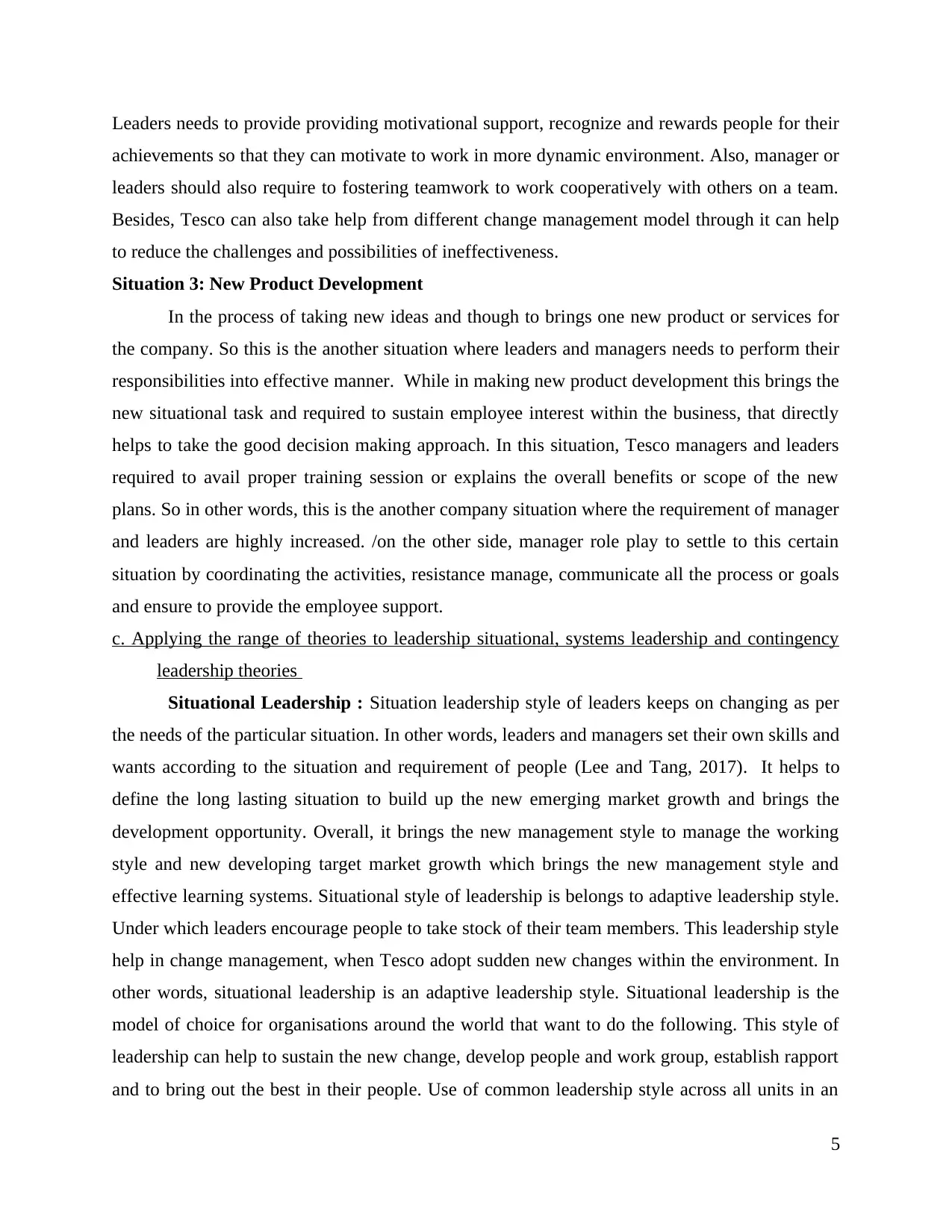
Leaders needs to provide providing motivational support, recognize and rewards people for their
achievements so that they can motivate to work in more dynamic environment. Also, manager or
leaders should also require to fostering teamwork to work cooperatively with others on a team.
Besides, Tesco can also take help from different change management model through it can help
to reduce the challenges and possibilities of ineffectiveness.
Situation 3: New Product Development
In the process of taking new ideas and though to brings one new product or services for
the company. So this is the another situation where leaders and managers needs to perform their
responsibilities into effective manner. While in making new product development this brings the
new situational task and required to sustain employee interest within the business, that directly
helps to take the good decision making approach. In this situation, Tesco managers and leaders
required to avail proper training session or explains the overall benefits or scope of the new
plans. So in other words, this is the another company situation where the requirement of manager
and leaders are highly increased. /on the other side, manager role play to settle to this certain
situation by coordinating the activities, resistance manage, communicate all the process or goals
and ensure to provide the employee support.
c. Applying the range of theories to leadership situational, systems leadership and contingency
leadership theories
Situational Leadership : Situation leadership style of leaders keeps on changing as per
the needs of the particular situation. In other words, leaders and managers set their own skills and
wants according to the situation and requirement of people (Lee and Tang, 2017). It helps to
define the long lasting situation to build up the new emerging market growth and brings the
development opportunity. Overall, it brings the new management style to manage the working
style and new developing target market growth which brings the new management style and
effective learning systems. Situational style of leadership is belongs to adaptive leadership style.
Under which leaders encourage people to take stock of their team members. This leadership style
help in change management, when Tesco adopt sudden new changes within the environment. In
other words, situational leadership is an adaptive leadership style. Situational leadership is the
model of choice for organisations around the world that want to do the following. This style of
leadership can help to sustain the new change, develop people and work group, establish rapport
and to bring out the best in their people. Use of common leadership style across all units in an
5
achievements so that they can motivate to work in more dynamic environment. Also, manager or
leaders should also require to fostering teamwork to work cooperatively with others on a team.
Besides, Tesco can also take help from different change management model through it can help
to reduce the challenges and possibilities of ineffectiveness.
Situation 3: New Product Development
In the process of taking new ideas and though to brings one new product or services for
the company. So this is the another situation where leaders and managers needs to perform their
responsibilities into effective manner. While in making new product development this brings the
new situational task and required to sustain employee interest within the business, that directly
helps to take the good decision making approach. In this situation, Tesco managers and leaders
required to avail proper training session or explains the overall benefits or scope of the new
plans. So in other words, this is the another company situation where the requirement of manager
and leaders are highly increased. /on the other side, manager role play to settle to this certain
situation by coordinating the activities, resistance manage, communicate all the process or goals
and ensure to provide the employee support.
c. Applying the range of theories to leadership situational, systems leadership and contingency
leadership theories
Situational Leadership : Situation leadership style of leaders keeps on changing as per
the needs of the particular situation. In other words, leaders and managers set their own skills and
wants according to the situation and requirement of people (Lee and Tang, 2017). It helps to
define the long lasting situation to build up the new emerging market growth and brings the
development opportunity. Overall, it brings the new management style to manage the working
style and new developing target market growth which brings the new management style and
effective learning systems. Situational style of leadership is belongs to adaptive leadership style.
Under which leaders encourage people to take stock of their team members. This leadership style
help in change management, when Tesco adopt sudden new changes within the environment. In
other words, situational leadership is an adaptive leadership style. Situational leadership is the
model of choice for organisations around the world that want to do the following. This style of
leadership can help to sustain the new change, develop people and work group, establish rapport
and to bring out the best in their people. Use of common leadership style across all units in an
5
⊘ This is a preview!⊘
Do you want full access?
Subscribe today to unlock all pages.

Trusted by 1+ million students worldwide
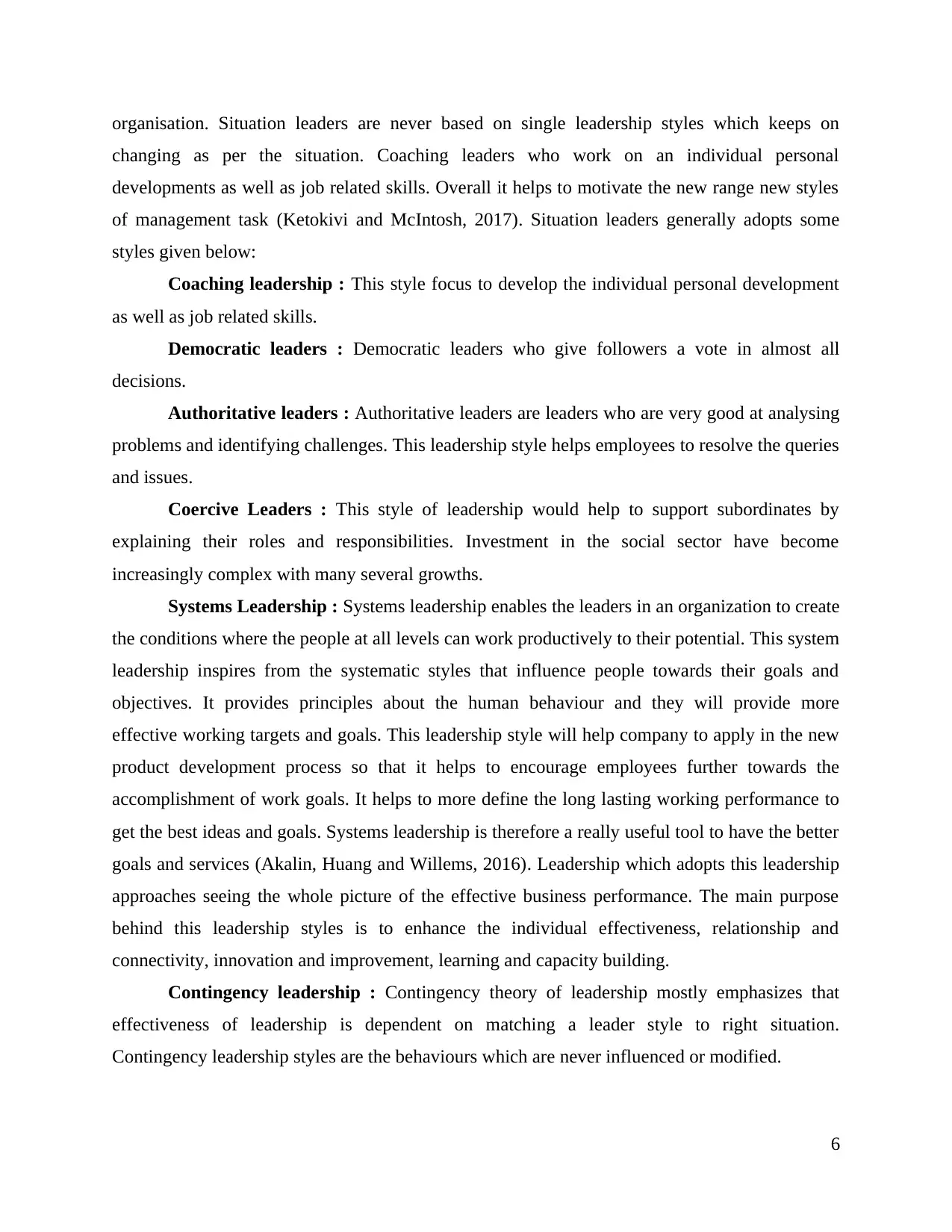
organisation. Situation leaders are never based on single leadership styles which keeps on
changing as per the situation. Coaching leaders who work on an individual personal
developments as well as job related skills. Overall it helps to motivate the new range new styles
of management task (Ketokivi and McIntosh, 2017). Situation leaders generally adopts some
styles given below:
Coaching leadership : This style focus to develop the individual personal development
as well as job related skills.
Democratic leaders : Democratic leaders who give followers a vote in almost all
decisions.
Authoritative leaders : Authoritative leaders are leaders who are very good at analysing
problems and identifying challenges. This leadership style helps employees to resolve the queries
and issues.
Coercive Leaders : This style of leadership would help to support subordinates by
explaining their roles and responsibilities. Investment in the social sector have become
increasingly complex with many several growths.
Systems Leadership : Systems leadership enables the leaders in an organization to create
the conditions where the people at all levels can work productively to their potential. This system
leadership inspires from the systematic styles that influence people towards their goals and
objectives. It provides principles about the human behaviour and they will provide more
effective working targets and goals. This leadership style will help company to apply in the new
product development process so that it helps to encourage employees further towards the
accomplishment of work goals. It helps to more define the long lasting working performance to
get the best ideas and goals. Systems leadership is therefore a really useful tool to have the better
goals and services (Akalin, Huang and Willems, 2016). Leadership which adopts this leadership
approaches seeing the whole picture of the effective business performance. The main purpose
behind this leadership styles is to enhance the individual effectiveness, relationship and
connectivity, innovation and improvement, learning and capacity building.
Contingency leadership : Contingency theory of leadership mostly emphasizes that
effectiveness of leadership is dependent on matching a leader style to right situation.
Contingency leadership styles are the behaviours which are never influenced or modified.
6
changing as per the situation. Coaching leaders who work on an individual personal
developments as well as job related skills. Overall it helps to motivate the new range new styles
of management task (Ketokivi and McIntosh, 2017). Situation leaders generally adopts some
styles given below:
Coaching leadership : This style focus to develop the individual personal development
as well as job related skills.
Democratic leaders : Democratic leaders who give followers a vote in almost all
decisions.
Authoritative leaders : Authoritative leaders are leaders who are very good at analysing
problems and identifying challenges. This leadership style helps employees to resolve the queries
and issues.
Coercive Leaders : This style of leadership would help to support subordinates by
explaining their roles and responsibilities. Investment in the social sector have become
increasingly complex with many several growths.
Systems Leadership : Systems leadership enables the leaders in an organization to create
the conditions where the people at all levels can work productively to their potential. This system
leadership inspires from the systematic styles that influence people towards their goals and
objectives. It provides principles about the human behaviour and they will provide more
effective working targets and goals. This leadership style will help company to apply in the new
product development process so that it helps to encourage employees further towards the
accomplishment of work goals. It helps to more define the long lasting working performance to
get the best ideas and goals. Systems leadership is therefore a really useful tool to have the better
goals and services (Akalin, Huang and Willems, 2016). Leadership which adopts this leadership
approaches seeing the whole picture of the effective business performance. The main purpose
behind this leadership styles is to enhance the individual effectiveness, relationship and
connectivity, innovation and improvement, learning and capacity building.
Contingency leadership : Contingency theory of leadership mostly emphasizes that
effectiveness of leadership is dependent on matching a leader style to right situation.
Contingency leadership styles are the behaviours which are never influenced or modified.
6
Paraphrase This Document
Need a fresh take? Get an instant paraphrase of this document with our AI Paraphraser
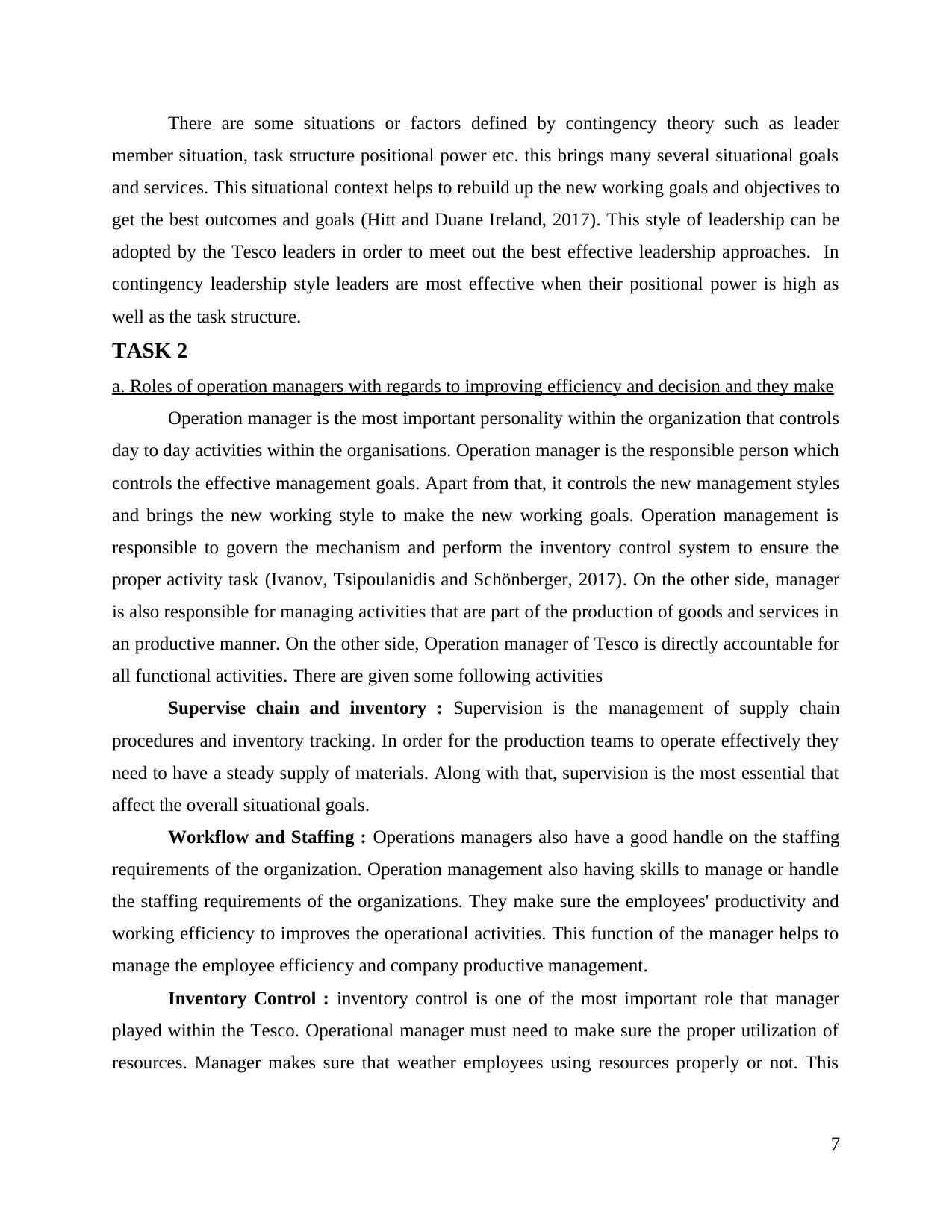
There are some situations or factors defined by contingency theory such as leader
member situation, task structure positional power etc. this brings many several situational goals
and services. This situational context helps to rebuild up the new working goals and objectives to
get the best outcomes and goals (Hitt and Duane Ireland, 2017). This style of leadership can be
adopted by the Tesco leaders in order to meet out the best effective leadership approaches. In
contingency leadership style leaders are most effective when their positional power is high as
well as the task structure.
TASK 2
a. Roles of operation managers with regards to improving efficiency and decision and they make
Operation manager is the most important personality within the organization that controls
day to day activities within the organisations. Operation manager is the responsible person which
controls the effective management goals. Apart from that, it controls the new management styles
and brings the new working style to make the new working goals. Operation management is
responsible to govern the mechanism and perform the inventory control system to ensure the
proper activity task (Ivanov, Tsipoulanidis and Schönberger, 2017). On the other side, manager
is also responsible for managing activities that are part of the production of goods and services in
an productive manner. On the other side, Operation manager of Tesco is directly accountable for
all functional activities. There are given some following activities
Supervise chain and inventory : Supervision is the management of supply chain
procedures and inventory tracking. In order for the production teams to operate effectively they
need to have a steady supply of materials. Along with that, supervision is the most essential that
affect the overall situational goals.
Workflow and Staffing : Operations managers also have a good handle on the staffing
requirements of the organization. Operation management also having skills to manage or handle
the staffing requirements of the organizations. They make sure the employees' productivity and
working efficiency to improves the operational activities. This function of the manager helps to
manage the employee efficiency and company productive management.
Inventory Control : inventory control is one of the most important role that manager
played within the Tesco. Operational manager must need to make sure the proper utilization of
resources. Manager makes sure that weather employees using resources properly or not. This
7
member situation, task structure positional power etc. this brings many several situational goals
and services. This situational context helps to rebuild up the new working goals and objectives to
get the best outcomes and goals (Hitt and Duane Ireland, 2017). This style of leadership can be
adopted by the Tesco leaders in order to meet out the best effective leadership approaches. In
contingency leadership style leaders are most effective when their positional power is high as
well as the task structure.
TASK 2
a. Roles of operation managers with regards to improving efficiency and decision and they make
Operation manager is the most important personality within the organization that controls
day to day activities within the organisations. Operation manager is the responsible person which
controls the effective management goals. Apart from that, it controls the new management styles
and brings the new working style to make the new working goals. Operation management is
responsible to govern the mechanism and perform the inventory control system to ensure the
proper activity task (Ivanov, Tsipoulanidis and Schönberger, 2017). On the other side, manager
is also responsible for managing activities that are part of the production of goods and services in
an productive manner. On the other side, Operation manager of Tesco is directly accountable for
all functional activities. There are given some following activities
Supervise chain and inventory : Supervision is the management of supply chain
procedures and inventory tracking. In order for the production teams to operate effectively they
need to have a steady supply of materials. Along with that, supervision is the most essential that
affect the overall situational goals.
Workflow and Staffing : Operations managers also have a good handle on the staffing
requirements of the organization. Operation management also having skills to manage or handle
the staffing requirements of the organizations. They make sure the employees' productivity and
working efficiency to improves the operational activities. This function of the manager helps to
manage the employee efficiency and company productive management.
Inventory Control : inventory control is one of the most important role that manager
played within the Tesco. Operational manager must need to make sure the proper utilization of
resources. Manager makes sure that weather employees using resources properly or not. This
7
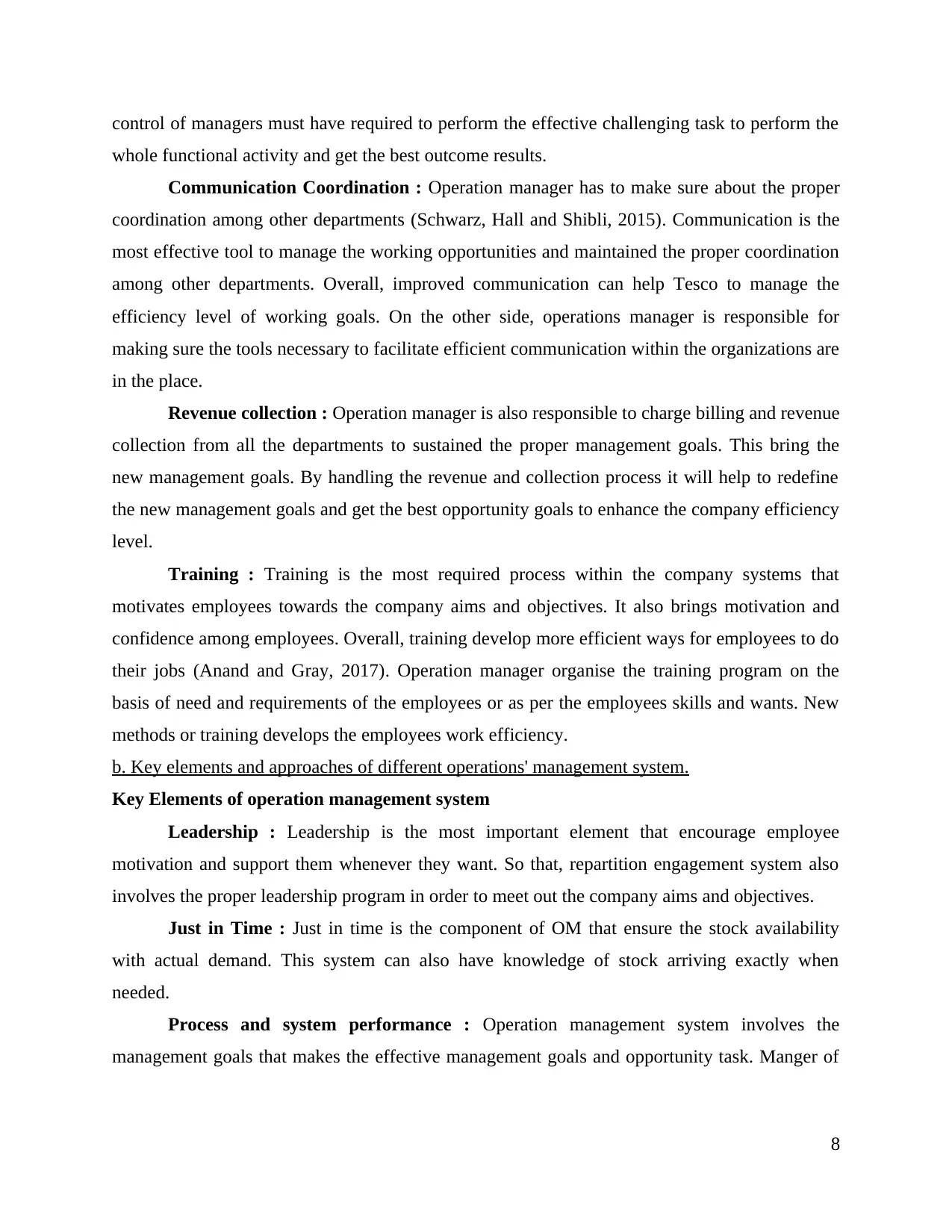
control of managers must have required to perform the effective challenging task to perform the
whole functional activity and get the best outcome results.
Communication Coordination : Operation manager has to make sure about the proper
coordination among other departments (Schwarz, Hall and Shibli, 2015). Communication is the
most effective tool to manage the working opportunities and maintained the proper coordination
among other departments. Overall, improved communication can help Tesco to manage the
efficiency level of working goals. On the other side, operations manager is responsible for
making sure the tools necessary to facilitate efficient communication within the organizations are
in the place.
Revenue collection : Operation manager is also responsible to charge billing and revenue
collection from all the departments to sustained the proper management goals. This bring the
new management goals. By handling the revenue and collection process it will help to redefine
the new management goals and get the best opportunity goals to enhance the company efficiency
level.
Training : Training is the most required process within the company systems that
motivates employees towards the company aims and objectives. It also brings motivation and
confidence among employees. Overall, training develop more efficient ways for employees to do
their jobs (Anand and Gray, 2017). Operation manager organise the training program on the
basis of need and requirements of the employees or as per the employees skills and wants. New
methods or training develops the employees work efficiency.
b. Key elements and approaches of different operations' management system.
Key Elements of operation management system
Leadership : Leadership is the most important element that encourage employee
motivation and support them whenever they want. So that, repartition engagement system also
involves the proper leadership program in order to meet out the company aims and objectives.
Just in Time : Just in time is the component of OM that ensure the stock availability
with actual demand. This system can also have knowledge of stock arriving exactly when
needed.
Process and system performance : Operation management system involves the
management goals that makes the effective management goals and opportunity task. Manger of
8
whole functional activity and get the best outcome results.
Communication Coordination : Operation manager has to make sure about the proper
coordination among other departments (Schwarz, Hall and Shibli, 2015). Communication is the
most effective tool to manage the working opportunities and maintained the proper coordination
among other departments. Overall, improved communication can help Tesco to manage the
efficiency level of working goals. On the other side, operations manager is responsible for
making sure the tools necessary to facilitate efficient communication within the organizations are
in the place.
Revenue collection : Operation manager is also responsible to charge billing and revenue
collection from all the departments to sustained the proper management goals. This bring the
new management goals. By handling the revenue and collection process it will help to redefine
the new management goals and get the best opportunity goals to enhance the company efficiency
level.
Training : Training is the most required process within the company systems that
motivates employees towards the company aims and objectives. It also brings motivation and
confidence among employees. Overall, training develop more efficient ways for employees to do
their jobs (Anand and Gray, 2017). Operation manager organise the training program on the
basis of need and requirements of the employees or as per the employees skills and wants. New
methods or training develops the employees work efficiency.
b. Key elements and approaches of different operations' management system.
Key Elements of operation management system
Leadership : Leadership is the most important element that encourage employee
motivation and support them whenever they want. So that, repartition engagement system also
involves the proper leadership program in order to meet out the company aims and objectives.
Just in Time : Just in time is the component of OM that ensure the stock availability
with actual demand. This system can also have knowledge of stock arriving exactly when
needed.
Process and system performance : Operation management system involves the
management goals that makes the effective management goals and opportunity task. Manger of
8
⊘ This is a preview!⊘
Do you want full access?
Subscribe today to unlock all pages.

Trusted by 1+ million students worldwide
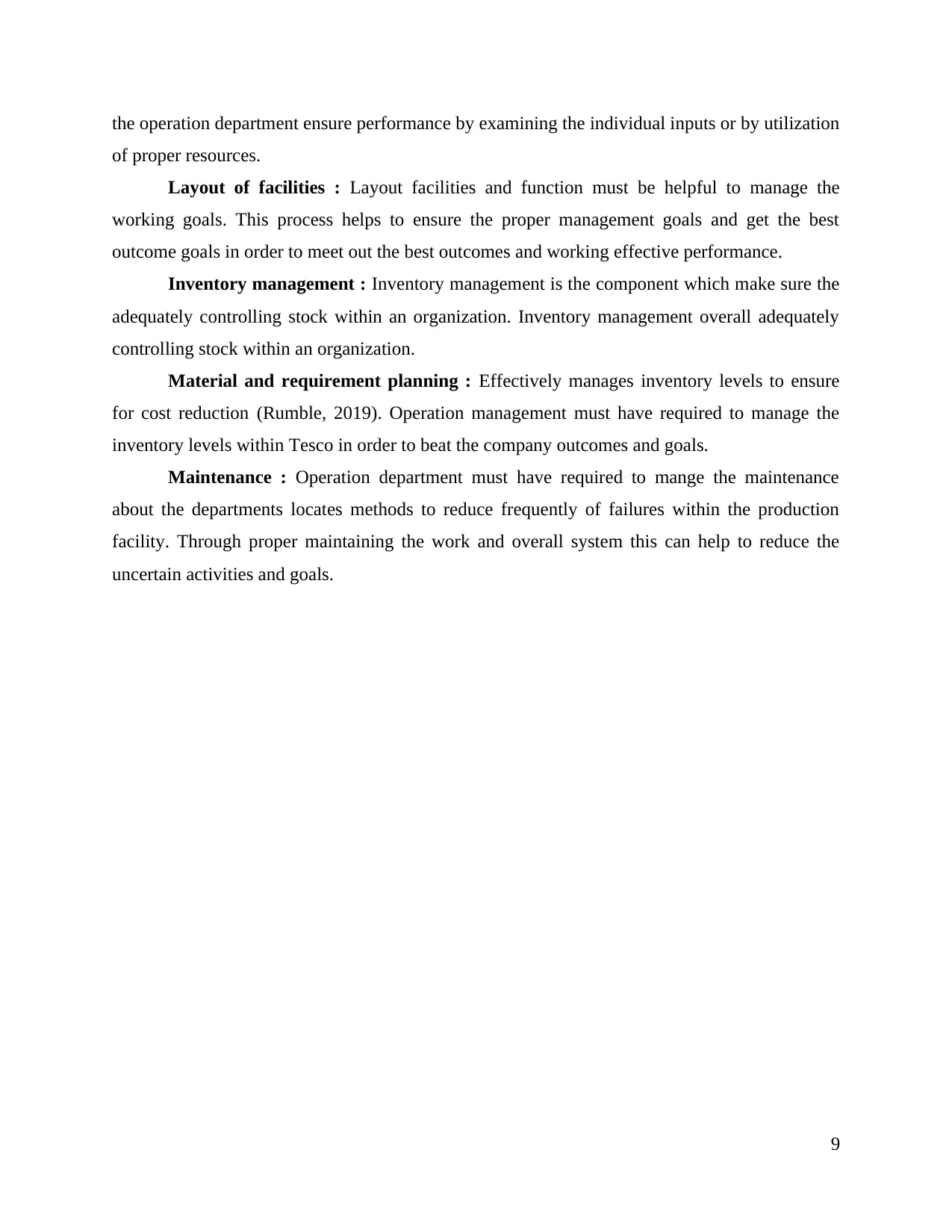
the operation department ensure performance by examining the individual inputs or by utilization
of proper resources.
Layout of facilities : Layout facilities and function must be helpful to manage the
working goals. This process helps to ensure the proper management goals and get the best
outcome goals in order to meet out the best outcomes and working effective performance.
Inventory management : Inventory management is the component which make sure the
adequately controlling stock within an organization. Inventory management overall adequately
controlling stock within an organization.
Material and requirement planning : Effectively manages inventory levels to ensure
for cost reduction (Rumble, 2019). Operation management must have required to manage the
inventory levels within Tesco in order to beat the company outcomes and goals.
Maintenance : Operation department must have required to mange the maintenance
about the departments locates methods to reduce frequently of failures within the production
facility. Through proper maintaining the work and overall system this can help to reduce the
uncertain activities and goals.
9
of proper resources.
Layout of facilities : Layout facilities and function must be helpful to manage the
working goals. This process helps to ensure the proper management goals and get the best
outcome goals in order to meet out the best outcomes and working effective performance.
Inventory management : Inventory management is the component which make sure the
adequately controlling stock within an organization. Inventory management overall adequately
controlling stock within an organization.
Material and requirement planning : Effectively manages inventory levels to ensure
for cost reduction (Rumble, 2019). Operation management must have required to manage the
inventory levels within Tesco in order to beat the company outcomes and goals.
Maintenance : Operation department must have required to mange the maintenance
about the departments locates methods to reduce frequently of failures within the production
facility. Through proper maintaining the work and overall system this can help to reduce the
uncertain activities and goals.
9
Paraphrase This Document
Need a fresh take? Get an instant paraphrase of this document with our AI Paraphraser
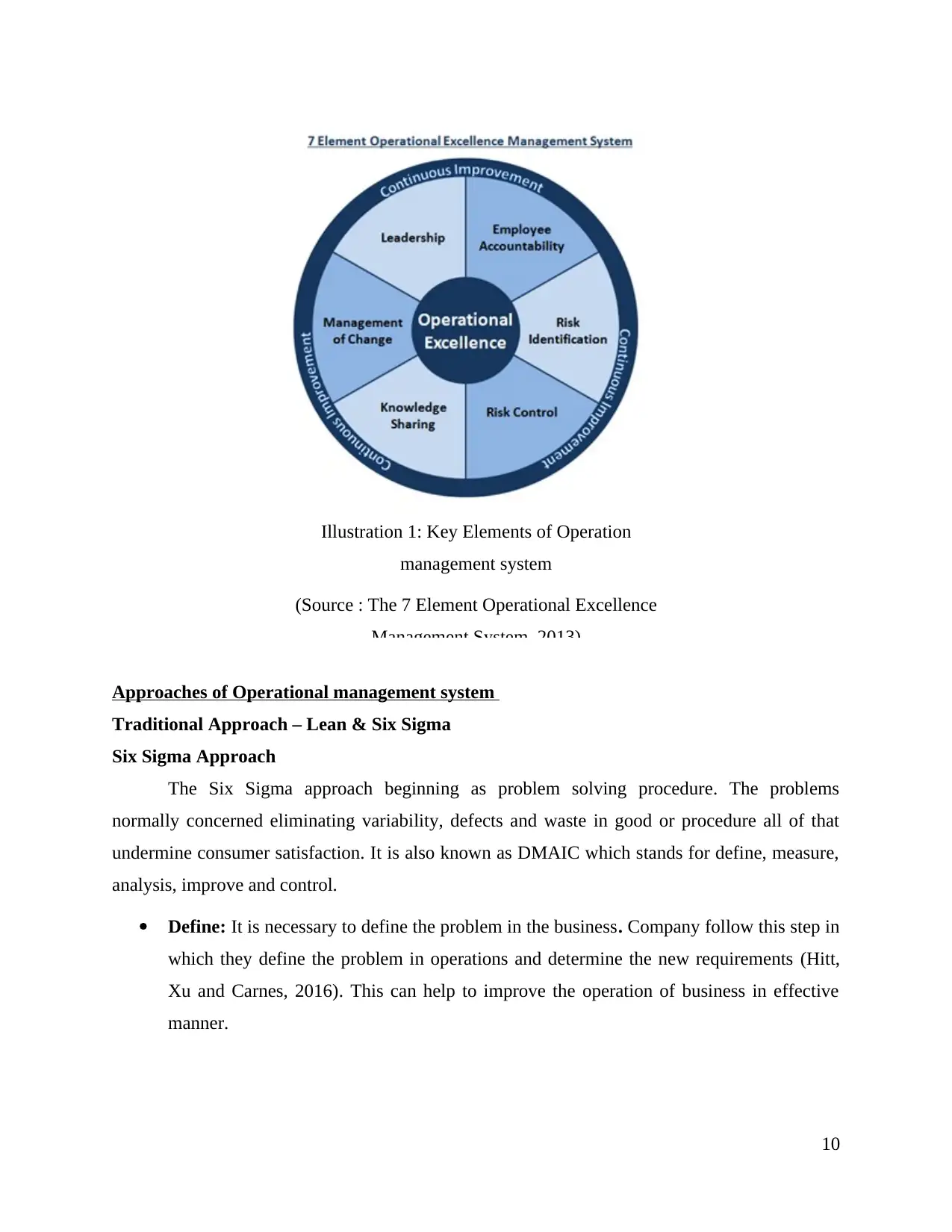
Approaches of Operational management system
Traditional Approach – Lean & Six Sigma
Six Sigma Approach
The Six Sigma approach beginning as problem solving procedure. The problems
normally concerned eliminating variability, defects and waste in good or procedure all of that
undermine consumer satisfaction. It is also known as DMAIC which stands for define, measure,
analysis, improve and control.
Define: It is necessary to define the problem in the business. Company follow this step in
which they define the problem in operations and determine the new requirements (Hitt,
Xu and Carnes, 2016). This can help to improve the operation of business in effective
manner.
10
Illustration 1: Key Elements of Operation
management system
(Source : The 7 Element Operational Excellence
Management System, 2013)
Traditional Approach – Lean & Six Sigma
Six Sigma Approach
The Six Sigma approach beginning as problem solving procedure. The problems
normally concerned eliminating variability, defects and waste in good or procedure all of that
undermine consumer satisfaction. It is also known as DMAIC which stands for define, measure,
analysis, improve and control.
Define: It is necessary to define the problem in the business. Company follow this step in
which they define the problem in operations and determine the new requirements (Hitt,
Xu and Carnes, 2016). This can help to improve the operation of business in effective
manner.
10
Illustration 1: Key Elements of Operation
management system
(Source : The 7 Element Operational Excellence
Management System, 2013)
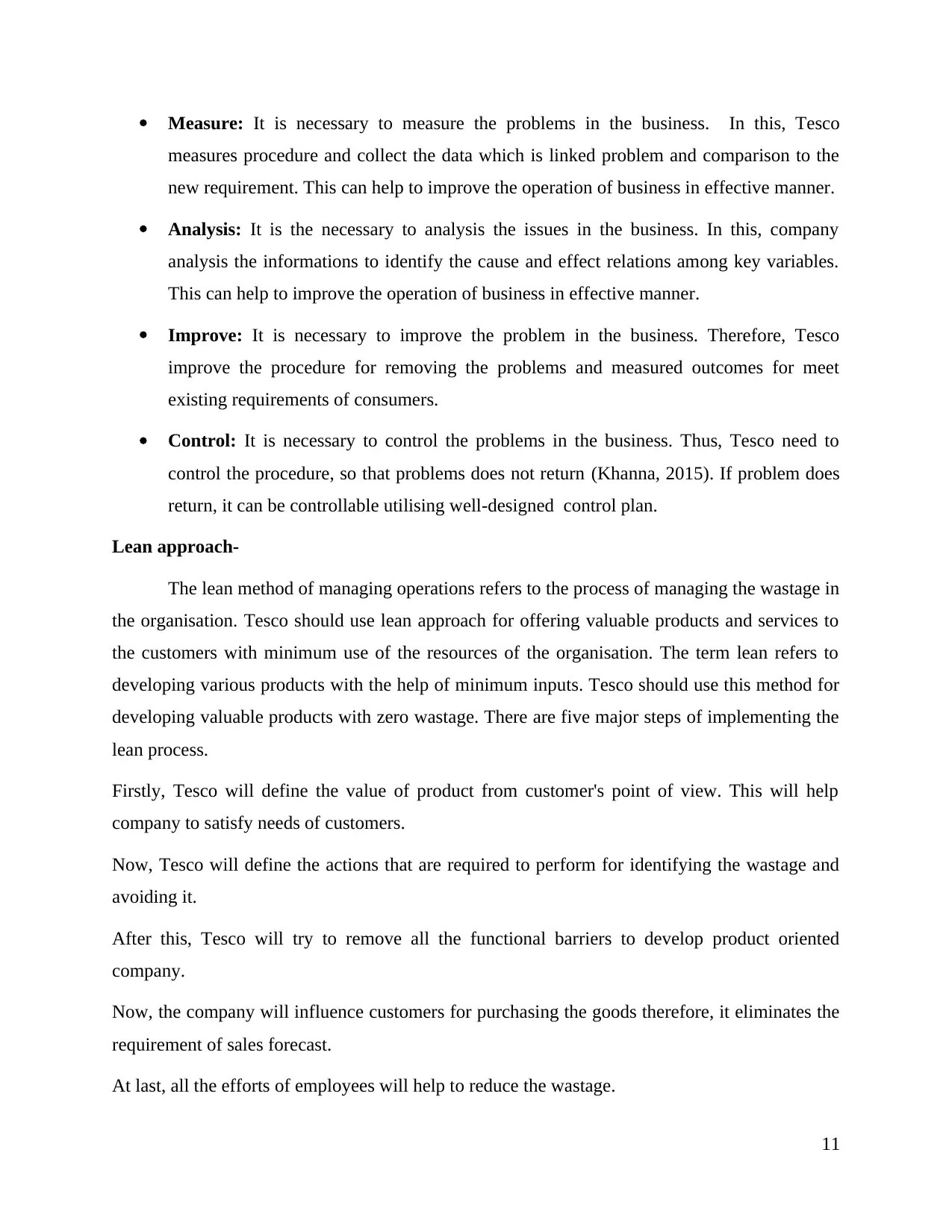
Measure: It is necessary to measure the problems in the business. In this, Tesco
measures procedure and collect the data which is linked problem and comparison to the
new requirement. This can help to improve the operation of business in effective manner.
Analysis: It is the necessary to analysis the issues in the business. In this, company
analysis the informations to identify the cause and effect relations among key variables.
This can help to improve the operation of business in effective manner.
Improve: It is necessary to improve the problem in the business. Therefore, Tesco
improve the procedure for removing the problems and measured outcomes for meet
existing requirements of consumers.
Control: It is necessary to control the problems in the business. Thus, Tesco need to
control the procedure, so that problems does not return (Khanna, 2015). If problem does
return, it can be controllable utilising well-designed control plan.
Lean approach-
The lean method of managing operations refers to the process of managing the wastage in
the organisation. Tesco should use lean approach for offering valuable products and services to
the customers with minimum use of the resources of the organisation. The term lean refers to
developing various products with the help of minimum inputs. Tesco should use this method for
developing valuable products with zero wastage. There are five major steps of implementing the
lean process.
Firstly, Tesco will define the value of product from customer's point of view. This will help
company to satisfy needs of customers.
Now, Tesco will define the actions that are required to perform for identifying the wastage and
avoiding it.
After this, Tesco will try to remove all the functional barriers to develop product oriented
company.
Now, the company will influence customers for purchasing the goods therefore, it eliminates the
requirement of sales forecast.
At last, all the efforts of employees will help to reduce the wastage.
11
measures procedure and collect the data which is linked problem and comparison to the
new requirement. This can help to improve the operation of business in effective manner.
Analysis: It is the necessary to analysis the issues in the business. In this, company
analysis the informations to identify the cause and effect relations among key variables.
This can help to improve the operation of business in effective manner.
Improve: It is necessary to improve the problem in the business. Therefore, Tesco
improve the procedure for removing the problems and measured outcomes for meet
existing requirements of consumers.
Control: It is necessary to control the problems in the business. Thus, Tesco need to
control the procedure, so that problems does not return (Khanna, 2015). If problem does
return, it can be controllable utilising well-designed control plan.
Lean approach-
The lean method of managing operations refers to the process of managing the wastage in
the organisation. Tesco should use lean approach for offering valuable products and services to
the customers with minimum use of the resources of the organisation. The term lean refers to
developing various products with the help of minimum inputs. Tesco should use this method for
developing valuable products with zero wastage. There are five major steps of implementing the
lean process.
Firstly, Tesco will define the value of product from customer's point of view. This will help
company to satisfy needs of customers.
Now, Tesco will define the actions that are required to perform for identifying the wastage and
avoiding it.
After this, Tesco will try to remove all the functional barriers to develop product oriented
company.
Now, the company will influence customers for purchasing the goods therefore, it eliminates the
requirement of sales forecast.
At last, all the efforts of employees will help to reduce the wastage.
11
⊘ This is a preview!⊘
Do you want full access?
Subscribe today to unlock all pages.

Trusted by 1+ million students worldwide
1 out of 17
Related Documents
Your All-in-One AI-Powered Toolkit for Academic Success.
+13062052269
info@desklib.com
Available 24*7 on WhatsApp / Email
![[object Object]](/_next/static/media/star-bottom.7253800d.svg)
Unlock your academic potential
Copyright © 2020–2025 A2Z Services. All Rights Reserved. Developed and managed by ZUCOL.





